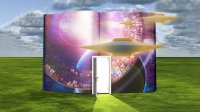Using Sci-Fi in the Science Classroom
Science fiction is a great entry point for helping elementary and middle school students think about science in new ways.
In an era when people feel the need to declare on bumper stickers and yard signs that they believe in science, it may seem odd to ask for more fiction in elementary science lessons. Yet science fiction is not a distraction—it’s a great way to spark innovation and to think critically about science. Many modern inventions were inspired by science fiction gadgets, such as cell phones (communicators in Star Trek) and submarines (Jules Verne’s Twenty Thousand Leagues Under the Sea). Scientists and engineers have said that the science fiction encountered in their childhood inspired their attitude toward science. Research also shows that science fiction fans think more carefully about the potential consequences of scientific breakthroughs than non-fans.
Not every child who hears a science fiction story will become a scientist, but science fiction is an opportunity for children to find that sense of wondrous possibility and to think critically about science, and these are benefits that you can incorporate into elementary and middle school science classrooms.
When you’re choosing science fiction for science classes, just about any book with science fiction tropes and characters like space travel or robots will help children develop familiarity with the language and common subjects of science fiction and will therefore help them develop the skills necessary for understanding more advanced science fiction. However, you’ll get a lot more return for your precious classroom time investment if you choose books that embody the qualities most prized in the science fiction genre.
In particular, look for books that don’t just go on a fun adventure but also feature speculation or extrapolation. Speculation refers to stories that ask what-if questions like “What would society be like if everyone were connected to the internet through a chip in their head?” Speculative stories are great for thinking about how much science impacts people.
Extrapolation refers to stories that imagine what a technology or society could be like in the future based on current trajectories, like how advances in medical prosthetics might eventually be able to replace whole bodies with machines. Extrapolative stories are great for thinking about how science grows and changes over time and what the science of the future might look like. Authors who utilize the speculative and extrapolative potential of science fiction often show how science can change the world.
How to Choose What Sci-Fi to Include
To help you evaluate whether science fiction stories for young readers meet these standards, here’s a condensed set of criteria taken from my book Equipping Space Cadets: Primary Science Fiction for Children:
- Is there a speculative what-if question or extrapolative “If this, then what?” question to the story?
- Does the ending imply that something has changed in the world or that new possibilities have opened due to the events of the story, however small?
- Would the story’s plot, themes, or lesson be different if you replaced the science components of the story with something realistic or magical?
If you’re still doubtful about including the imaginary in a science class, one of the best lessons to do with science fiction is to actively identify the realistic versus the fictional. Science fiction often plays with ideas that are possible but currently improbable (like faster-than-light travel and full artificial intelligence) or impossible ideas that pose interesting questions about the possible (like time travel or teleportation). Identifying these situations together in the classroom doubles as great practice for being critical about information.
Have your students use a graphic organizer like a Venn diagram. On one side, list the realistic components of the story; on the other side, the absolutely made-up and impossible parts. Then, in the middle, the not-yet-possible or the unknown. I’ve done this activity before with Mr. Wuffles!, by David Wiesner, a book that features insect-size aliens. The kids had great discussions about whether aliens belonged in the impossible or unknown sections, based on their knowledge about space and how much is left to discover about the universe.
One common reading instruction practice, the interactive read aloud (IRA), offers a great way to make the most of a science fiction story in the classroom. By intentionally planning questions to ask as you read aloud, you can guide your audience to think critically about science as well as the morals and consequences of science.
For instance, include an IRA during a unit on inherited traits. After students look at how animals pass down traits and how practices like dog breeding and genetic engineering purposely reproduce certain traits, read a science fiction story like the picture book The Barnabus Project, by the Fan Brothers. Throughout the story, ask questions about the scientific tools and the science required for the events of the story to happen, as well as questions about how that science is affecting the characters. In the end, ask students to consider how scientific advances might seem good or bad based on different perspectives.
Overall, science fiction is a great entry point for thinking about science and its place in society. It helps us to consider how science is deeply tied to ethics. Science fiction also reminds us that science isn’t all just about what’s already been discovered; it is also all about the unknown and embracing what we don’t yet understand. Knowing what’s real and what’s fiction is an important skill, but so is knowing that the fictional can sometimes become reality—through science.
